Genesis: The first Canadian tank
When news of the British Expeditionary Force evacuation at Dunkirk, loosing all their heavy equipment in the process, reached Canada, it was clear that if the Canadians wished to be committed in the conflict, no UK-built tanks would be spared for them at least for an estimated two years. At the same time, prospects from the USA were bleak as well, as all the deliveries were to be assigned to the UK first. So any armored forces levied in Canada had to be equipped with a domestic tank. Following these conclusions, the Government prospected the Canadian Pacific Railway's Angus Shops in Montreal (CPR), the only factory capable of large scale production of such vehicles, equipped with the heavy infrastructure required. In the meantime, this company already signed a contract to produce 300 Valentine tanks (partially fitted) under licence, which had to be shipped for completion in the UK, followed by 480 more for the Canadian mechanized infantry divisions (as an infantry support tank).A cruiser design based on the M3 Lee/Grant
The Canadians, already producing the Valentine, soon conducted a study to produce their own domestic cruiser tank. By 1940, CPR production of the Valentine (1940 would be produced in all, most shipped to the USSR) teethed with difficulties while using British and US parts and facing the need to adapt their manufacturing processes to US standards and methods. Mid-production, the Canadian Joint Committee on Tank Development reported that any domestic design would depend first and foremost on US-built parts. The only available model recently put in production was the M3 Lee. At first a licensed production was favored, but the Canadians were not impressed by the compromise design, which was eventually rejected.Characteristics
The Canadian Interdepartmental Tank Committee, which was charged with the Ram design, chose a compromise solution, with the chassis, suspension, drivetrain, engine and a rewoked transmission of the M3. The upper part of the hull, a single piece entirely made of cast iron was to be completely redesigned, including a fully traversing turret (also made of a single cast part) housing the main armament, a British type 6-pdr. This ambitious enterprise encountered many difficulties. To simplify construction the manufacturer replicated or bought as many parts from the M3 and later the M4 Sherman, and British parts, as possible. L.E.Carr, an expert in tank design, was hired and conceived a lower, more compact hull than that of the original M3. The turret was roomy enough to be equipped later with a 75 mm (2.95 in) gun. The most intriguing part was the British-influenced forward secondary turret, equipped with two Browning machine-guns. This feature, still very present in British designs, would be seen as obsolete and dropped in late 1942 on the Mk. II. The driver sat on the right, conform to British specifications. The lateral doors of the M3 prototypes were also seen as a good idea, for the safety of the crew and easier access, despite being an obvious weak spot.Production - Ram Mark I
Montreal Locomotive Works (MLW), an experienced subsidiary of the American Locomotive Company (ALCO), already subcontracted for the M3, was chosen to mold the upper part of the hull. The final assembly was given to the specially funded Canadian Tank Arsenal at Longue Pointe, Québeck, responsible for the nose (with three rolled plates bolted together), the lower and upper parts, turret fitting and all the finishes and furniture. Soon, it was found that producing all the required components took time to gear up. Second, it appeared that the Continental engine and transmissions were in short supply back in the US, which further delayed the completion of the first model. The US-built 75 mm (2.95 in) was not chosen despite its superior caliber compared to the British 6 pounder, mainly because of inferior AP capability and muzzle velocity. But it was also in short supply back in the UK, and a compromise was chosen for the first batch of the Mark Is (50). All received a puny -but largely available- 2-pdr (40 mm/1.57 in) instead. The prototype was ready in June 1941 and the production started in November. By February 1942 the Factory had stockpiled enough QF-6 pounders to ensure a steady mass-production, and the Mark II was born.The Ram Mark II
The Mk.II was by far the main production of the Ram, and saw many modification until the production was resumed in July 1943. The early production was almost unchanged except for the new gun it was previously designed for, the fast-firing 6 pounder (57 mm/2.24 in) Mk.III (L/43), a more compact, tank version of the Mk.II. This model was later designated the "short" version. The auxiliary "twin-tubes" turret was kept, and well as the coaxial machine-gun and side door. The mantlet which protected both was internal. In March 1942, the company took a radical departure when deciding to use US parts designed exclusively for the M4A1 Sherman. The most obvious change were the new VVSS suspension and tracks, as well as the elimination of the side doors which weakened the hull. At the same time, the locally-built M4 production was delayed, allowing the manufacture of many more Rams and derivatives. The final evolution of the Mark II was signaled by the elimination of the auxiliary turret and a slightly redesigned, simplified front cast hull. The gun was also new, the long barrel (L/50) QF 6-pdr Mk.IV, equipped with a single baffle muzzle brake.Operational service
The Ram's fate shares some similarities with the Sentinel, the Australian domestic cruiser. The same considerations about the Sherman being delivered in large quantities prevailed. And just as the production was so slow to gear up, the factory line was converted for the Sherman, leaving no sufficient numbers of Rams to fit correctly in the Canadian armored divisions. Globally, the Ram was clearly a huge progress compared to the M3 Lee, but only a slightly better design compared to the Sherman, given the fact it was lower and more compact, and had a gun capable of better performances. However, the British-US mixed requirements ended as a relatively complex and much costlier tank than the M4. It was decided already in 1943 to send them in Great Britain for training, and they served as such until mid-1944, when many were converted for other tasks. By 1947, UK delivered 44 Rams to the Royal Netherlands army, added to those already dumped in Holland (not converted Kangaroos), for a total of 73. By 1952 they were replaced by Centurions, most ended into the IJssel Line, embedded in concrete as static pillboxes.Variants
Contrary to the original Ram, most of its conversions and variants actually saw action in the European battlefields: Holland, France, Germany, Italy. The Sexton was the most famous derivative of all.Sexton SPG
After endless changes, the series was more or less finalized with the Sexton II, (125th unit), still armed with a 25 pounder which could be used in direct fire as an antitank gun. The 3-piece transmission housing appeared to have lingered until the 474th vehicle. Track type varied dramatically. The most obvious recognition feature are the batteries and auxiliary generator boxes with their accompanying water can holders on either side at the rear. Canadian dry pin track and heavy duty suspension with trailing idlers also depict the Sexton II.Ram Badger
This turretless variant was based on the Kangaroo APC, modified to use the Mk.II flamethrower already made famous by the Wasp (based on the Universal Carrier). The turret ring was covered, and surplus auxiliary turrets were mounted on top of these. The second series were complete vehicles, the turret receiving the flamethrower apparatus. Most served in Holland.Ram Kangaroo
"Kangaroo" was the generic denomination for all turretless or converted Armored Personnel Carriers, based on the M3 Lee, M4 Sherman and Churchill chassis, or the "Defrocked Priest". These vehicle were open-top, all internal storage was dismounted to make room for 6-10 men and their equipment. The only armament remaining was the nose hull Browning. These vehicles saw action in Holland and Normandy.Ram OP/Ram Command
The Forward Observation Officers (FOO) attached to each Sexton SPG company needed some form of protection, which was provided by mobile observation posts made of the 84 converted vehicles from last batch of the Mk. II. Their gun were replaced by a dummy, and a powerful set of radios were added in the turret. The Ram GPO used alongside had additional equipment and Tannoy loudspeakers.Ram Wallaby
The standard ammunition carrier derived from the Kangaroo, which followed the Sexton SPG companies.Ram ARV
The Armored Recovery Vehicle based on a Ram Chassis, built in two series (Mk. I and II). The first was based on the Ram Mk. I had a winch, while the second one derived from the Mk. II had a jig and earth spade.Ram gun tower
This tractor version based on the Kangaroo had a reinforced towing hook designed for the Ordnance QF 17 pounder. They also carried the ammunition and gun crew.Ram Mk.II specifications |
|
| Dimensions | 5.80 x 3 x 2.67 m (19 x 9.10 x 8.9 ft) |
| Total weight, battle ready | 29 tons (65,000 lbs) |
| Crew | 5 (commander, driver, co-driver/machine-gunner, gunner, loader) |
| Propulsion | Continental R-975 9-cyl radial Gasoline 400 hp (298 kW) |
| Maximum speed | 40 km/h (25 mph) - P/w ratio 12.3 hp/ton |
| Transmission | Borg-Warner clutch, controlled differential |
| Suspension | Vertical Volute Springs (VVSS) |
| Range | 232 km (144 mi) |
| Armament | Main : 6-pdr (57 mm/2.24 in) MkIII - 92 rounds
Secondary: 3 x.303 cal. (7.69 mm) Browning machine guns -4400 rounds |
| Armor | Maximum 87 mm (3.42 in) |
| Total production | 1948 (tank versions only) |
Links about the Ram Tank
The Ram on Wikipedia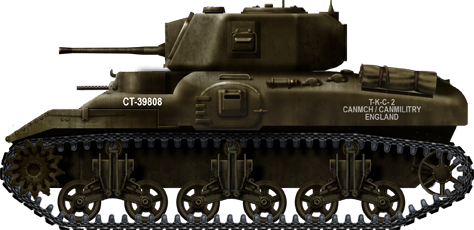
Ram Mk. I, early production, equipped with the QF 2-pounder (40 mm/1.57 in). Only 50 were built between December 1941 and February 1942.
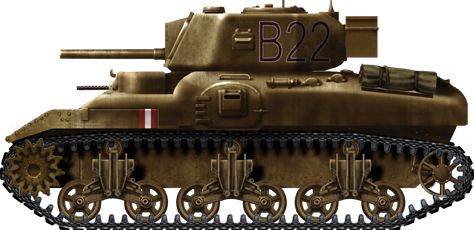
Ram Mk.II, early production, with the 6-pdr (57 mm/2.24 in) Mk. III, auxiliary turret and US M3 type suspensions, in khaki brown livery. It is from the Lord Strathcona\'s Horse training unit, belonging to the Canadian 5th Armored Division, based in Great Britain in late 1942.
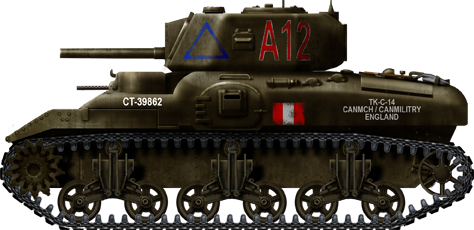
Ram Mk.II, early production, from the "A" Sqn, Grey and Simcoe Foresters, 2nd Army Tank Brigade, based in Great Britain by mid-1942.
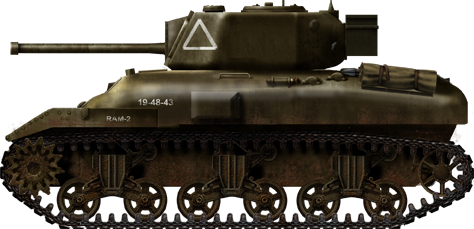
Ram Mk.II, late production, with the long barrel 6-pdr Mk. V. It lost its sponson doors and auxiliary turret and received the new US M4 type VVSS suspensions.
Variants & derivatives
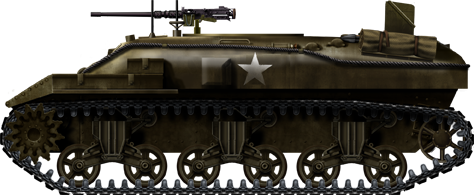
Ram Kangaroo of an unidentified unit, Normandy, 1944. This was one of the four improvised APCs types used to cope with the lack of M5 Half-Tracks.
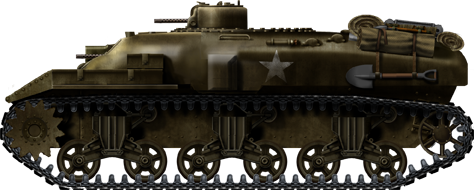
Ram Badger, early version. These were regular Kangaroos modified with Mk. II Wasp equipment. This one was repaired in the field with M4A4 drive sprockets.
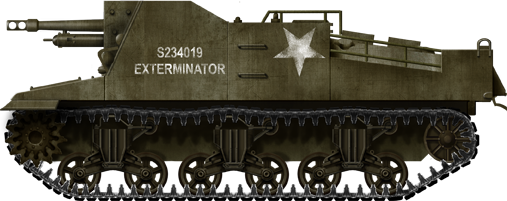
Sexton Mk. II "Exterminator" in Italy, 1944. The series was standardized after the 125th unit as the Sexton Mk.II. About 1436 were produced until early 1945 (S-233626 to S-235061). They soldiered mostly in Italy, and Holland. (Not to scale)
Gallery

Ram Mk.I at base Borden

Ram tank in operations (Royal Canadian archives)

Ram mark 3 at base Borden


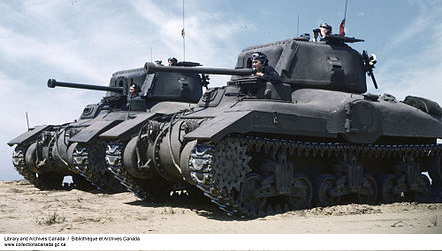


WW2 Tanks




























WW2 tanks posters

All Tiger tanks liveries.

Panther liveries and variants

WW2 Armour - All tanks











Tanks aces and single tanks series

Find more there

Museums, Movies, Books & Games
The Tanks and Armor in pop culture
Tanks and armored vehicles in general are only really grasped when seen first person: The mass, the scale, it's all there. Explore also the way tanks were covered in the movie industry, in books and in video games.Movies:
Best tanks movie on warhistoryonline.com
On imdb.com
On bestsimilar.com/
miltours.com
liveabout.com/
watchmojo.com
Video Games:
pcgamesn.com
historyhit.com
levvvel.com
vg247.com/best-tank-games
mmobomb.com/
alienwarearena.com

